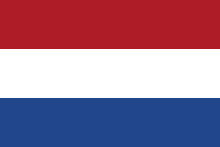Dutch Empire
Appearance


The Dutch empire comprised the overseas territories and trading posts controlled and administered by Dutch chartered companies—mainly the Dutch West India Company and the Dutch East India Company—and subsequently by the Dutch Republic (1581–1795), and by the modern Kingdom of the Netherlands after 1815. It was initially a trade-based system which derived most of its influence from merchant enterprise and from Dutch control of international maritime shipping routes through strategically placed outposts, rather than from expansive territorial ventures. The Dutch were among the earliest empire-builders of Europe, following Spain and Portugal.
| This geography-related article is a stub. You can help out with Wikiquote by expanding it! |
Quotes
[edit]- The preference of the Navy Staff was to launch assaults on Hong Kong, Singapore and Malaya, while at the same time overrunning Dutch Sumatra, Borneo and Java. Their assumption, which proved entirely correct, was that the European empires in Asia had been dealt lethal blow at home by the German occupation of the Netherlands and France and the continuing German threat to the British Isles. The Dutch colonies, in particular, looked like easy quarry; they had the added allure of being oil-rich. Malaya, meanwhile, was the world's biggest producer of rubber. Living space for Japanese settlers was all very well, but the Japanese Empire needed strategic raw materials far more urgently. In 1940 army planners had argued for an invasion of Indo-China, to provide new bases from which to attack the Chinese Nationalists in Sichuan. As War Minister in the new Cabinet formed by Prince Konoe in July 1940, Tôjô had insisted that unless Japan struck soon, she risked being too late. By 1941, it is true, some senior generals had become less enthusiastic about this idea. But by now the proponents of the Southern strategy had the upper hand.
- Niall Ferguson, The War of the World: Twentieth-Century Conflict and the Descent of the West (2006), pp. 484-485
- In all, 52 per cent of Japanese military personnel deployed overseas served in China, compared with 33 per cent in the Pacific theatre and 14 per cent in South-East Asia. These figures also provide some indication of the relative ease with which the Japanese were able to oust the European empires. By any standards, these were low-hanging fruit. The Dutch colonies were defended by a fleet of 5 cruisers, 8 destroyers and 24 submarines, an air force of 50 obsolescent planes and an army of just 35,000 regulars with 25,000 reservists… With good reason the forces of the European empires in Asia have been called 'Forgotten Armies';
- Niall Ferguson, The War of the World: Twentieth-Century Conflict and the Descent of the West (2006), pp. 485
- The establishment of a sugar processing infrastructure in colonial Java persistently increased industrialization, education, and household consumption in areas near government sugar factories, even after the factories themselves had disappeared. Similarly, villages forced to grow sugar cane for the Cultivation System have more schooling and manufacturing today… the positive impacts on economic activity plausibly dominated [any negative effects] in the long-run.
- The Case for Colonialism: A Response to My Critics, Page 6 Kendhammer citing Ochonu, 2009
- The composition of Unilever should serve as a warning that colonialism was not simply a matter of ties between a given colony and its mother country, but between colonies on the one hand and metropoles on the other. The German capital in Unilever joined the British in exploiting Africa and the Dutch in exploiting the East Indies. The rewards spread through the capitalist system in such a way that even those capitalist nations who were not colonial powers were also beneficiaries of the spoils. Unilever factories established in Switzerland, New Zealand, Canada, and the U.S.A. were participants in the expropriation of Africa’s surplus and in using that surplus for their own development.
- Walter Rodney, How Europe Underdeveloped Africa. Howard University Press. 1972. p. 190. ISBN 978-0-9501546-4-0.
- These people were of all races, colors, and creeds. French were in the north and in the Carolinas. Dutch had built the town on Manhattan island, and their patroons' estates in the Hudson valley; now they were building their own cabins in the Mohawk Indian country that is now New York State. Germans had settled in the Jerseys and in the far west, beyond Philadelphia. Germans and Scotch-Irish were climbing the Carolina mountains; Swedes were in Delaware, English and French and Dutch and Irish were settled in Massachusetts, the New Hampshire Grants, Connecticut, and Virginia. Mingled with all these were Italians, Portuguese, Finns, Arabs, Armenians, Russians, Greeks, and Africans from a dozen very different African peoples and cultures. Black, brown, yellow and white, all these peoples were some of them free and some of them slaves. Also they were intermarried with the American Indians.
- Rose Wilder Lane, §1 of "The Third Attempt," ch. V of Pt. Two of The Discovery of Freedom: Man's Struggle Against Authority (New York: The John Day Company, 1943), pp. 153–154.
Dutch East India Company
[edit]- Jesus Christ is good, but trade is better.
- Unofficial motto, reported in Peter FitzSimons, Batavia (2011), introduction, epigraph
See also
[edit]External links
[edit]- De VOCsite
- Dutch and Portuguese Colonial History
- VOC Kenniscentrum
- Dutch East Indies Documentary on YouTube
- The Atlas of Mutual Heritage database, showing the Dutch empire 1600–1800.


